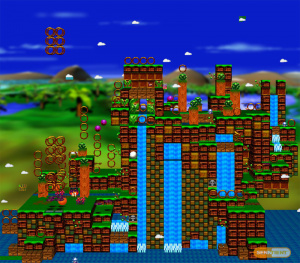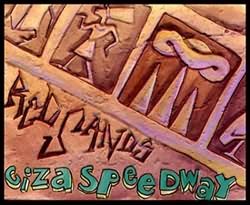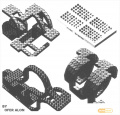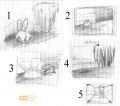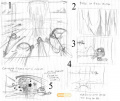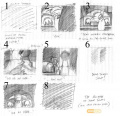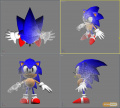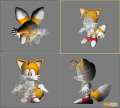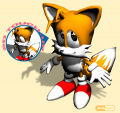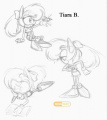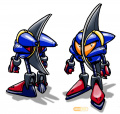Sonic X-treme/Development
From Sonic Retro
Revision as of 02:06, 17 December 2023 by CartridgeCulture (talk | contribs) (+Prerelease, still WIP)
- Back to: Sonic X-treme.
Development process
Saturn development
Because of internal disputes between Michael Kosaka and Dean Lester, Kosaka left Sega in 1995, leaving the still-young Sonic Mars without a lead designer. Chris Senn, who had never been in a leadership position before in such an ambitious project, was thrust into the job. Though given the impression it was only a temporary position until another, more experienced designer could be found, he held the position through most of the development of the game. It was around this time that the Saturday morning cartoon elements were dropped from the game, and the decision to switch platforms to the next generation Sega system was brought up.
Due to the confusion behind what the true successor to the Mega Drive was to be, an effort was made to focus the development on the proposed cartridge-based nVidia-powered system being developed by Sega of America. Though the system promised to be even more capable at 3D rendering than Sega of Japan's "Project Saturn", a failed demonstration of the nVidia chip caused Sega of America's project to be turned down, and development shifted once again to a new console.
With the project fully underway, development for Sonic X-treme was split into two separate groups. The first, led by Chris Senn and programmer Ofer Alon, focused on the main body of the game, creating the worlds that Sonic would run through. The second group, led by programmer Christina Coffin, was tasked with creating the boss encounters, with a completely separate engine started in the 32X-era of the project.
Both teams were watched over by Mike Wallis, who also become responsible for the smaller groups forming in each team, focusing on different aspects of development. Even though these divisions were meant to make development easier, in practice the entire process was a mixture of inconsistency and confusion. With certain people working on levels that hadn't been approved, others waiting until the programming was done, and lack of communication across the board, it was clear that this would not be an easy undertaking.
Originally developed on the Macintosh platform, Ofer Alon's engine was quickly ported over to the PC, with the intent being to port the code to the Sega Saturn. While the levels played smoothly on the PC, Ofer's early attempts at porting the code to the Saturn were anything but, a framerate of only three or four being the maximum. This, coupled with the numerous delays and internal arguments at SOA, prompted the executives to intervene.
At a meeting with Alon and Senn, technical director at STI, Robert Morgan informed the duo that they were bringing in a third party, a company called Point Of View (POV), to take over programming duties for the game. Showing the two a very basic display of Sonic on a checkerboard surface, Senn could not help but scoff at them. Though POV's stated purpose was to port Alon's work to the Saturn, it was made clear that yet another layer had been added to the X-treme development saga, Ofer Alon essentially being demoted. While Ofer took it in stride, Chris Senn was livid, unable to believe that Sega would want to essentially start from scratch.
Regardless, work on the engine continued, with Ofer Alon secluding himself to focus. POV, meanwhile, began its attempt to port an older version of the engine, finding it just as difficult as Ofer did when he tried, if not more so. Making matters worse, in March of 1996, a group of representatives from Sega of Japan (including then-president Hayao Nakayama) visited the American branch, expecting a presentation of the work done so far to Sonic X-treme. Instead, effectively two presentations emerged - one demonstrating Chris and Ofer's PC engine, and another by POV.
Viewing the broken efforts of POV, Nakayama was furious at the state of the project, oblivious to the fact that it was not reflective of the work being done by Ofer. Pointing to the engine being the boss battles, he ordered STI to make the rest of the game like that. By the time Chris Senn arrived, the Japanese executives were already tense, and though he had a brief moment to mention that another, further along presentation was on its way, nerves got the better of him[1]. Due to the poor reception of STI's first showing, Nakayama and the rest had already left the building when Ofer Alon arrived[1].
In the aftermath of the meeting, STI was left with little choice but to follow Nakayama's demands, dropping both Ofer Alon's and POV's work. Making Christina Coffin lead programmer, Sonic X-treme became "Project Condor", but as STI focused its resources to this new iteration of the game, the "old" one continued, with Ofer Alon and Chris Senn now on their own.
Sonic PC
Even though they had been removed from the project, Chris Senn (who was also suffering severe medical issues as a result of Sonic X-treme) and Ofer Alon continued to work on the engine and the textures used for the levels. Creating another presentation, the two showed off their work to the PC division of Sega with the hope that the game would be released on PC, where it always worked at the proper framerate.
The management declined to take it on, citing it was not in their budget to finance a new game, preferring to stick with ports of existing Sega titles[1]. While Chris Senn believed the real reasons were just more internal politics at Sega because of Nakayama's distaste for the shoddy port of Ofer's work[1], the end result was still the same. Ceasing work on Sonic X-treme, Ofer left the company, thus putting an end to the Sonic X-treme development saga.
Assets from the game's development would, however see an official release in Sonic's Schoolhouse. As both were being developped concurrently, it was decided to repurpose artist Ross Harris' existing Sonic the Hedgehog model for prerenders of Schoolhouse's titular character. Fittingly, Ross Harris is credited in the game’s Special Thanks.
Prerelease
Sonic X-treme was officially announced at E3 1996[2][3][4][5] to reportedly "thunderous applause" from the attending press.[6] The game was revealed to use pre-rendered graphics[7][3] and would take advantage of both the Saturn's VDP1 and VDP2 co-processors.[8][9][5] With just this appearance alone, X-treme was already being touted as Sega's answer to Super Mario 64[10][11], with Game Players claiming the two would be each other's largest competitors in the platform game market.[12] Alongside generic comparisons to Super Mario 64 came a great number of direct comparisons to Sega's earlier 3D action-platformer, Bug!.[2][13][10][14] Understanding that this comparison would be less than flattering for the game's first appearance, Sega of America were quick to assure the gaming press that X-treme would not resemble Bug![15][13][10]
Despite promises that X-treme would be Sega's "next-best thing", gaming magazines generally had a rather unenthusiastic response.[12][16][17] Many pointed out the game's emptiness[18][19][12], while others expressed doubts over the playability of the reflex lens feature[20] (these particular doubts were even shared by the developers, who stated the reflex lens took "about 30 seconds of adjustment"[21]). The Japanese version of Sega Saturn Magazine also claimed the game was only 20% complete by the time of its E3 1996 appearance.[22] Compounding these poor initial impressions was the lack of actual content on display at the show, which consisted of only a 45-second demo boasting limited interactivity and a brief promotional video largely lacking in gameplay.
The playable version of the game on the show floor was a version of Project Condor which allowed Sonic to run around a noninteractive "boss arena" against a green gemstone, and was initially available for play at one of three glass-protected Sega Saturn systems at Sega's dedicated Sonic X-treme booth. This first playable appearance was described as a timed[11] "bonus round"[12] featuring little else to do than "constantly run around in circles".[7] Sonic himself was followed by impressive lighting and trails of colored particles[7], and was notably high-framerate and smooth[11] (despite one magazine claiming the experience was "full of bugs"[23]).
Unfortunately, any excitement for the game seems to have died down rather quickly, as Hyper magazine noted the "complete absence of crowds around the X-treme booth" due to its general "lack of anything playable".[24] At some point during the show, two of the three demo systems were disabled and their televisions set to play an X-treme promotional videos instead (possibly to make the game's lack of crowds less apparent). These promotional videos, one of which features a parody of Mario expressing his fear of the upcoming Sonic game, were reportedly just as unimpressive.[25]
Behind the scenes, another version of Project Condor was shown off. Available only to specially-invited members of the gaming press, this backroom allowed video game magazines and television shows into a dedicated area staffed by Sega of America representatives, where the company could offer a more-thorough preview into its upcoming products. In one example, Phil Guerrero of the Canadian television series The Anti-Gravity Room was invited to preview a number of titles, where he met with Sega's Angela Edwards in this dedicated press backroom. Edwards was dressed in army fatigues for the theme of Operation Revolution, described as "full-fledged Sega warfare" (FILEREF) (in reference to the company's uphill battle for the Christmas 1996 season), and demonstrated a special version of Condor never seen before: the boss fight with Mecha Sonic in a purple-skied Robotropolis.
Sega also held an E3 1996 prerelease party the night of May 15th: Sega Rocks the House of Sonic Blues[4]. Held at the House of Blues restaurant and music venue in Los Angeles, California, it was attended by the gaming press, members of Sega AM2, and executives from Sega of America and Sega Europe, among others. Sonic the Hedgehog himself was in attendance to give away "golden rings" and Sonic tattoos to partygoers. While the party uses X-treme's render of Sonic and is loosely themed around the character, existing press coverage does not appear to mention the game whatsoever.
This would not be the only time Sega of America's confidence in X-treme appeared to waver during the event. Despite Sonic being the company's flagship franchise, the game would completely forgo being included in the Sega Saturn's take-home "sizzle reel" VHS. In addition, much of the advertising material and marketing momentum created for X-treme during this time seems to have been stripped of its ties to the project and reused to co-promote the Mega Drive and Saturn versions of Sonic 3D: Flickies' Island. (NEEDSREF)
Following its appearance at E3 1996, the game received very little gaming press.[6] Shoichiro Irimajiri's fateful March 1996 visit had somehow leaked out of Sega and had since become an "open secret" within the video game industry, and even Yuji Naka was reportedly interviewed speaking poorly of the project. Understandingly, there were no known plans to release X-treme in Japan.[22] The game's last known appearance would be at Sega Gamer's Day 1996[26], where a photograph published in MAGHERE suggests Project Condor's version of the Jade Gully "playground" was once playable by the public. FILEREF
One of the first outlets to break news of the game's cancellation was Game Fan Online that August 23rd.[27] In the following weeks, a number of other outlets would follow up with identical announcements, with some press citing vague quality concerns and X-treme's gameplay not suiting a Sonic game as reasons for its cancellation.[16] Some magazines even directly referenced Irimajiri's visit[28][29], and claimed the upcoming Saturn version of Sonic 3D: Flickies' Island was being readied as a last-minute replacement for X-treme.[30][31]
E3 1996
| |
Main article: Sonic X-treme/Development/E3 1996 |
Storylines
| |
Main article: Sonic X-treme/Development/Storylines |
Concept art
Over the course of Sonic X-treme's development cycle, a slew of concept art and other various images were created as the team behind the game brainstormed how best to go about producing Sonic's first appearance on the Sega Saturn. Some of these ideas never went beyond the drawing board, while others evolved into various forms of playable content until X-treme's cancellation.
General
By Ofer Alon.
Storyboards
Storyboard for an animated version of the Sega Technical Institute logo.
Sonic the Hedgehog
During the early development of X-treme, part of the team's ambitious ideas was to feature numerous playable characters, each with their own individual play style. Chris Senn, the game's lead designer, wanted Sonic to be controlled in an isometric view's similar to what would eventually be seen in Sonic 3D: Flickies' Island, but was convinced otherwise by lead programmer Ofer Alon.
Sonic wearing a strange Santa Claus hat, likely related to the unfinished Christmas level.
Miles "Tails" Prower
Though not demonstrated in the below concept art, Miles "Tails" Prower's gameplay was envisioned to be that found in most modern 3D games, with a third-person, camera-behind-you perspective. When the game was focused onto just Sonic, the titular character inherited this format of perspective.
Knuckles the Echidna
To keep things fresh, the player was to control Knuckles the Echidna from a top-down view, the camera showing off the maze surrounding their character.
Tiara Boobowski
Tiara Boobowski, commonly mistaken for a hedgehog but actually a Minx Kitten, was meant to be the new character introduced in Sonic X-treme. First conceived as a princess, she later become the daughter of a professor, but each time was meant to be a love interest for Sonic. Though later game outlines made her nothing but plot fodder, she was originally meant to be playable, to be controlled in traditional side-scrolling platformer levels.
Other characters
Chaz/Gabby
Included within the "PackageX" leak of 2009, a set of sprites for two characters, "Chaz" and "Gabby," were found within. They were created by Chris Senn for a personal, unrelated side-project using the X-Treme level editor, and were used as test art.
Hirokazu Yasuhara concept art
Near the tail-end of development for Sonic X-treme on the Saturn, Sega of America called upon veteran Sonic game designer Hirokazu Yasuhara to lend his expertise in the ever-problematic X-treme development cycle. His concepts continued to be used during the "Project Condor" phase of the project, but none were successfully utilized in a complete game.
The layout to enter the Death Egg Zone.
Box art
References
- ↑ 1.0 1.1 1.2 1.3 Sonic Xtreme FAQ by Chris Senn (2008-12-23)
- ↑ 2.0 2.1 [mms, issue 45, page 26 mms, issue 45, page 26]
- ↑ 3.0 3.1 [cvg, issue 176, page 90 cvg, issue 176, page 90]
- ↑ 4.0 4.1 [ssm, issue 9, page 6 ssm, issue 9, page 6]
- ↑ 5.0 5.1 [gamepro, issue 95, page 44 gamepro, issue 95, page 44]
- ↑ 6.0 6.1 [ssm, issue 10, page 10 ssm, issue 10, page 10]
- ↑ 7.0 7.1 7.2 [segamagazin, issue 32, page 6 segamagazin, issue 32, page 6]
- ↑ [maniac, issue 1996-07, page 19 maniac, issue 1996-07, page 19]
- ↑ [sgp, issue 29, page 15 sgp, issue 29, page 15]
- ↑ 10.0 10.1 10.2 [nextgeneration, issue 19, page 67 nextgeneration, issue 19, page 67]
- ↑ 11.0 11.1 11.2 [egm, issue 84, page 74 egm, issue 84, page 74]
- ↑ 12.0 12.1 12.2 12.3 [gameplayers, issue 0908, page 57 gameplayers, issue 0908, page 57]
- ↑ 13.0 13.1 [gameplayers, issue 0906, page 40 gameplayers, issue 0906, page 40]
- ↑ [playerone, issue 65, page 88 playerone, issue 65, page 88]
- ↑ File:GamePro83june1996pageunknown.jpg
- ↑ 16.0 16.1 [mms, issue 49, page 8 mms, issue 49, page 8]
- ↑ [maximum, issue 7, page 73 maximum, issue 7, page 73]
- ↑ [mms, issue 45, page 27 mms, issue 45, page 27]
- ↑ [ssm, issue 9, page 32 ssm, issue 9, page 32]
- ↑ [saturnfan, issue 1996-13, page 185 saturnfan, issue 1996-13, page 185]
- ↑ [gameplayers, issue 0907, page 43 gameplayers, issue 0907, page 43]
- ↑ 22.0 22.1 [ssmjp, issue 1996-10, page 90 ssmjp, issue 1996-10, page 90]
- ↑ [playmag, issue 5, page 32 playmag, issue 5, page 32]
- ↑ [hyper hyper]
- ↑ [hyper, issue 34, page 25 hyper, issue 34, page 25]
- ↑ [egm, issue 87, page 112 egm, issue 87, page 112]
- ↑ http://www.lostlevels.org/200403/timeline.shtml (Wayback Machine: 2023-06-21 01:35)
- ↑ [nextgeneration, issue 23, page 19 nextgeneration, issue 23, page 19]
- ↑ [megaforce, issue 54, page 20 megaforce, issue 54, page 20]
- ↑ [ssm, issue 12, page 10 ssm, issue 12, page 10]
- ↑ [megaforce megaforce]
| Sonic X-treme | |
|---|---|
|
Main page (Point of View|Project Condor|SonicPC) |
show;hide
|
